Also by Nancy Farmer, another Newbery Honor book, is A Girl Named Disaster. Set in  contemporary Mozambique and Zimbabwe, this wonderful tale of survival, bravery and redemption was also a really cool field guide to African plants and animals. There's a fabulous passage in which Nhamo, the main character, lives among a troop of baboons. After reading Sapolsky's A Primate's Memoir, I was particularly fond of this passage, because Farmer's depictions of the baboons and their social structure matched up with Sapolsky's non-fiction (neuroscientist's perspective) account. Good for kids (probably mostly girls, but I'd try boys on it anyway) ages 10 and up, this novel also serves as a really great introduction to the nature of daily life in different places in Africa. Though Nhamo comes from a tribal village, she travels in solitude in the wilderness, and then ends up in a large city. The cast of characters include her fellow tribesmen, missionaries, Portuguese traders, jaguars, baboons, ghosts, scientists... the list goes on. Vividly decsribed, and thoroughly rendered, A Girl Named Disaster is a great book for kids who like learning about other cultures, or survival/adventure stories.
contemporary Mozambique and Zimbabwe, this wonderful tale of survival, bravery and redemption was also a really cool field guide to African plants and animals. There's a fabulous passage in which Nhamo, the main character, lives among a troop of baboons. After reading Sapolsky's A Primate's Memoir, I was particularly fond of this passage, because Farmer's depictions of the baboons and their social structure matched up with Sapolsky's non-fiction (neuroscientist's perspective) account. Good for kids (probably mostly girls, but I'd try boys on it anyway) ages 10 and up, this novel also serves as a really great introduction to the nature of daily life in different places in Africa. Though Nhamo comes from a tribal village, she travels in solitude in the wilderness, and then ends up in a large city. The cast of characters include her fellow tribesmen, missionaries, Portuguese traders, jaguars, baboons, ghosts, scientists... the list goes on. Vividly decsribed, and thoroughly rendered, A Girl Named Disaster is a great book for kids who like learning about other cultures, or survival/adventure stories.
Pullman, author of the amazing Dark Materials Trilogy, (which I plan to reread around Christmas, it's an awesome cold-weather read) is expert at taking large, complex ideas and making them accessible for kids. In this case, rather than a making a deftly crafted treatise against organized religion, Pullman turns his eye on storytelling. And,  in less than two hundred pages, he doesn't just address the writer's side, but also the process in which stories are created and the many mechanisms within stories that make them move forward. Hence the very apt comparison to clocks, which are, throughout the entire story, a relentless motif. That was my reading of it.
in less than two hundred pages, he doesn't just address the writer's side, but also the process in which stories are created and the many mechanisms within stories that make them move forward. Hence the very apt comparison to clocks, which are, throughout the entire story, a relentless motif. That was my reading of it.
But what really makes this book awesome is that it's a good, straight ahead story, too. It boasts a rich cast of characters, including a brave young heroine, an overwhelmed clockmaker, a writer and a man who may or may not be the devil himself. It does have a few scary moments (murders can be rough for the more sensitive readers and this one is pretty visceral), and so generally I would recommend it for ages eight and up to avoid nightmares with the younger, precocious readers who read above their level. It's not as creepy as Coraline, by Neil Gaiman (which I also totally recommend, a succinct, fun but totally creeperiffic) which I have received more than one angry customer complaint about on the grounds that it is too, too scary. But it IS scarier than, say, a Roald Dahl book, even if that headmistress CAN chuck you into the great, blue yonder.
Sometimes, I can't remember if I actually read a book as a child, or if my older sister, Mikka, did, and just told me the entire plot so comprehensively that I
think that I did. Like Lloyd Alexander's
Westmark Trilogy, (an awesome series about a revolution that goes from the

books up) the Newbery Winner,
A Wrinkle in Time, was a book I knew the story of, but had never actually read. I realized this when I reread it last month, and came across passages I knew I had never heard before-- passages of startling imaginative resonance, and surprising (but realistic) romance. I can see, easily, why this book won the Newbery.
L'Engle said, in her Newbery acceptance speech, that the best books are the ones that provide just a little bit of light against the overwhelming darkness of our world. And
A Wrinkle in Time is a book that does just that. According to Lewis Buzbee (author of the fabulous
Steinbeck's Ghost, which, incidentally, begins with a reference to Comazotz, the scary-zombie-like planet) more people site
A Wrinkle in Time as their favorite childhood book, than any other title. While I can't agree (because I never read it as a child) I can see how this would be true. The possibilities for a child's impact on the world, as imagined in this story, are vast, yet still dependent on innate traits any child might have. Walking the line between fantasy and science-fiction, with the emotional rawness of realism,
A Wrinkle in Time was a pleasure to finally read.
Adventures in badassery!
Scott Westerfeld, the author of the fun, body-image-centered trilogy, Uglies, Pretties, 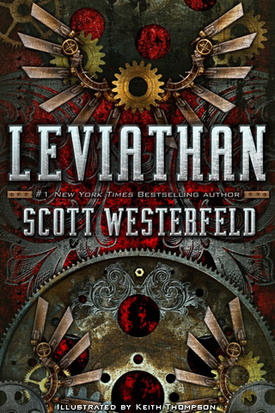 Specials, the vampire series, Peeps, and puzzle-horror series, Midnighters, has a new book out, the beginning to a very promising new series. Leviathan, a steam-punk retelling of WWI, is a rollicking start to what I'm hoping is going to be Westerfeld's best series yet! Perspective switches every two chapters between an unseated prince (Aleks), who has been humbled by his parents' deaths, and Derryn, a cross-dressing girl in the British Royal Navy. Driving both characters is the need to keep their true identities secret, and when their paths cross, their central tensions blend in compelling and juicy (yes, juicy) ways.
Specials, the vampire series, Peeps, and puzzle-horror series, Midnighters, has a new book out, the beginning to a very promising new series. Leviathan, a steam-punk retelling of WWI, is a rollicking start to what I'm hoping is going to be Westerfeld's best series yet! Perspective switches every two chapters between an unseated prince (Aleks), who has been humbled by his parents' deaths, and Derryn, a cross-dressing girl in the British Royal Navy. Driving both characters is the need to keep their true identities secret, and when their paths cross, their central tensions blend in compelling and juicy (yes, juicy) ways.
Like all Westerfeld's novels, Leviathan kicks off the action immediately, and I was hooked from page one. This world of Clankers (large, mechanical war vehicles) and Darwinist Beasties (hybrid war animal-machines) is so much fun that even though I was seriously pissed when I realized that this book was the first in a series (I shake my fist at you, Scott Westerfeld!!! Now I have to wait???) I can't say I'm not excited to spend more time in this world. For those readers that enjoyed Hunger Games, His Dark Materials, or Eon, this book might be a go. Like Hunger Games, this book moves quickly. Like His Dark Materials it occurs in a world that is at once an alternate past and a possible future. And like Eon, it features a strong, cross-dressing lead, succeeding in a man's role.
I am a little embarrassed to admit I didn't actually read this... I listened to it on audio on the drive from Seattle to San Francisco, as read by the (badass) Alan Cummings (who does an AWESOME job, seriously, AMAZING) but I liked it so much I'm going to read a hard copy, too. I suggest you do, too!
If you're a kid (or adult) who hasn't read Lloyd Alexander's Prydain Chronicles (Newbery Honor for the second book, The Black Cauldron and Newbery Winning for the High King , a series starting with The Book of Three) do it. Sure, it's kind of a Lord of the Rings knockoff for kids, but Alexander's ear for poetry in prose is undeniable, and perfectly suited for children's literature. I loved those books as a kids, and as an adult, reread (sort of... I never really read it in the first place, but knew the plot of all three books since my sister told me the stories so many times I might as well have read them) the Westmark Trilogy, a fabulous trilogy about a revolution from the books up.
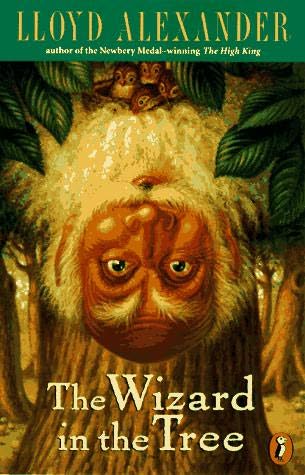 So when I found this odd title, The Wizard in the Tree, at my favorite used bookstore in the bay area (Dark Carnival, go guys go) I had to read it. And while it was not quite as good as some of Alexander's other, more famous work, it was still an incredibly enjoyable read, perfect for middle grade readers in the middle of the pack, ages 8 to 12. At times funny, others violent (there are some murders), this book creates a wonderful anti-Potter definition of the true nature of magic, with some clever environmentalist themes that make it timely, even if it is the silly story of a little girl who finds a wizard in a tree.
So when I found this odd title, The Wizard in the Tree, at my favorite used bookstore in the bay area (Dark Carnival, go guys go) I had to read it. And while it was not quite as good as some of Alexander's other, more famous work, it was still an incredibly enjoyable read, perfect for middle grade readers in the middle of the pack, ages 8 to 12. At times funny, others violent (there are some murders), this book creates a wonderful anti-Potter definition of the true nature of magic, with some clever environmentalist themes that make it timely, even if it is the silly story of a little girl who finds a wizard in a tree.
Complete with plucky heroine, curmudgeonly wizard, and eeeevil (yes, so evil he's eeeevil) squire, The Wizard in the Tree is a clever story from a very clever author, whose breadth of work I am just beginning to appreciate.
And seriously, read the Prydain Chronicles, and its awesome companion book of short stories, The Foundling. Awesome.
When I finished the 1968 Newbery Honor book, The Egypt Game, I could for no stretch of the imagination see why it hadn't simply won straight out. Until I realized it was an honor book the year that my very very favorite, From the Mixed-Up Files of Mrs. Basil E. Frankweiler, was the winner. Fair enough, Newbery, fair enough. Apparently 1968 was a good year for kids books, because The Egypt Game was a wonderful story about imagination, learning and the joy of play. I'm so sad I didn't read this book as a child. I know my older sister did, because I found her copy at our mom's house (and didn't steal it, it's still there Mikka, I promise). But I know I would have loved it then, for the very same reasons I love it now.
 The Egypt Game starts from the perspective of April Hall, a little girl who's just moved to a new neighborhood so that she can live with her grandmother while her mother runs around Hollywood. Despite the fact that April finds the new town far too provincial for her tastes, she soon makes friends with the decidedly less precocious Melanie Ross, and by proxy, Melanie's very serious little brother, Marshall (who never goes anywhere without his safety octopus, aptly named Safety). The three begin playfully reenacting ancient Egyptian rituals, and are soon joined by two boys, Ken and Toby. With five players in the Egypt game, all bringing their own ideas and research to the table, the game becomes more serious, and when strange things start happening, the kids can't help but wonder if they are making it happen. Meanwhile, a child murderer is in the neighborhood, and everyone suspects the Professor, the strange old man whose backyard is the secret location for the Egypt game.
The Egypt Game starts from the perspective of April Hall, a little girl who's just moved to a new neighborhood so that she can live with her grandmother while her mother runs around Hollywood. Despite the fact that April finds the new town far too provincial for her tastes, she soon makes friends with the decidedly less precocious Melanie Ross, and by proxy, Melanie's very serious little brother, Marshall (who never goes anywhere without his safety octopus, aptly named Safety). The three begin playfully reenacting ancient Egyptian rituals, and are soon joined by two boys, Ken and Toby. With five players in the Egypt game, all bringing their own ideas and research to the table, the game becomes more serious, and when strange things start happening, the kids can't help but wonder if they are making it happen. Meanwhile, a child murderer is in the neighborhood, and everyone suspects the Professor, the strange old man whose backyard is the secret location for the Egypt game.
It's a silly thing to focus on, since there are so many wonderful things about this book, but I loved the characterization of Ken Kamata. Ken plays very reluctantly, and is always a little embarrassed and incredibly self-conscious. There's a fabulously funny illustration in the chapter entitled: Ceremony for the Dead, in which all the children are shown in the wild throws of a dramatic funeral. All except Ken, who (despite being in character by beating his chest) is looking straight out of the page at the reader, a slightly embarrassed look on his face, as though even doing this in front of the reader is just more humiliation than he can bear. Maybe I just like Ken, because when I was a kid, I was a bit like him. I wish I had been a kid like Marshall, but so it goes.
I don't think you can even throw a rock without finding a third or fourth grader who's curious about ancient Egypt. So throw a rock, hit a kid and then buy them a copy of this book. The parents will totally drop charges when they see how awesome the book is. Or you'll go to jail with a funny story about bad advice and good kids books.

The Newbery Winner of 1987 (and illustrated by the great Peter Sis)
The Whipping Boy was a surprisingly funny read, complete with dancing bear, blundering con men and a bratty prince with an untapped heart. Even kids who are not necessarily interested in historical fiction will find points of interest in this book. The story is told from the perspective of the prince's whipping boy, an orphan named Jemmy. If you, like me, before I read this book, have no idea what a whipping boy is, it's a designated person to suffer punishments on the prince's behalf. Since the prince in this tale is rotten, Jemmy takes many whippings, a fact the prince cares about very little. When they run away together, Prince Brat (as he is also called) begins to learn the errors of his ways, and he and Jemmy strike up an unlikely friendship. At 89 pages long, even more reluctant readers will be unafraid to pick up this absurd little tale of empathy, trust and friendship. Perfect for early readers making the transition to chapter books, with a pleasantly snarky narrative voice.
Alas, I am terrible at keeping up with this blog. But, fortunately, I'm better at reading than I am at writing, and so I have plenty of books to write about! For today, I'll start with these 3:
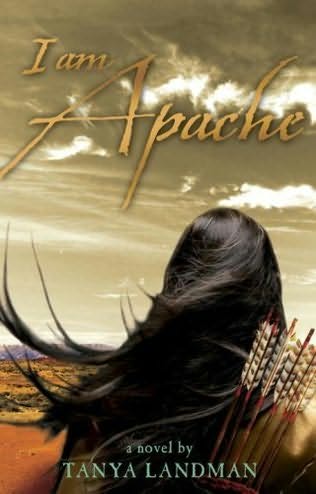 I Am Apache, by Tanya Landman: A YA book meant for readers age 12 and up (but that I have already recommend to mature 10 year old readers), I Am Apache is an elegantly written story about an Apache (duh) woman who decides, after the untimely and violent death of her younger brother, to follow the path to become a warrior. All my ra-ra-ra feminism aside, it's an psychologically compelling read, if not a little heavy-handed. One of the things I've found myself wondering as I read it was (since Landman is British, and hence has not been subjected to all the PA announcement tropes including Native Americans and the environment, you know the one, with the one tear) if some of the language choices were a little stale. A "heart soaring like an eagle over the plain" for example, did not feel particularly fresh. But other than moments like that (of which there were relatively few) it's a wonderful read for those who want to be a tough woman, who are tough women already, or just love tough women on principle.
I Am Apache, by Tanya Landman: A YA book meant for readers age 12 and up (but that I have already recommend to mature 10 year old readers), I Am Apache is an elegantly written story about an Apache (duh) woman who decides, after the untimely and violent death of her younger brother, to follow the path to become a warrior. All my ra-ra-ra feminism aside, it's an psychologically compelling read, if not a little heavy-handed. One of the things I've found myself wondering as I read it was (since Landman is British, and hence has not been subjected to all the PA announcement tropes including Native Americans and the environment, you know the one, with the one tear) if some of the language choices were a little stale. A "heart soaring like an eagle over the plain" for example, did not feel particularly fresh. But other than moments like that (of which there were relatively few) it's a wonderful read for those who want to be a tough woman, who are tough women already, or just love tough women on principle.
 Jasper Dash and the Flame-Pits of Delaware by MT Anderson: Anderson is always my favorite. Even when he's writing silly stories in a fictional Delaware, complete with kangaroo-riding cannibals, he's always the best. In this case for the motherly advice not to fall in love with boys whose names are like boarding schools (Choate, Thatcher, etc) because they'll just break your heart. Sound advice, Mrs. Mulligan. Sound advice. Jasper Dash is the third book in the Pals in Peril Series (previous MT Anderson's Thrilling Tales), a middle grade series in which each book is a satire of a particular genre-- the first was an alien invasion story, the second a mystery. This newest installment is an adventure story, akin to Tarzan, but with way more silliness. It's by far the longest volume in the series, and there are some parts where it gets a little long. But I could see why. I probably wouldn't want to edit anything out either, even if not doing so is to the detriment of the flow. Anderson's fictitious Delaware is so much fun, so absurd, so silly, that I for one couldn't pick anything that had to go.
Jasper Dash and the Flame-Pits of Delaware by MT Anderson: Anderson is always my favorite. Even when he's writing silly stories in a fictional Delaware, complete with kangaroo-riding cannibals, he's always the best. In this case for the motherly advice not to fall in love with boys whose names are like boarding schools (Choate, Thatcher, etc) because they'll just break your heart. Sound advice, Mrs. Mulligan. Sound advice. Jasper Dash is the third book in the Pals in Peril Series (previous MT Anderson's Thrilling Tales), a middle grade series in which each book is a satire of a particular genre-- the first was an alien invasion story, the second a mystery. This newest installment is an adventure story, akin to Tarzan, but with way more silliness. It's by far the longest volume in the series, and there are some parts where it gets a little long. But I could see why. I probably wouldn't want to edit anything out either, even if not doing so is to the detriment of the flow. Anderson's fictitious Delaware is so much fun, so absurd, so silly, that I for one couldn't pick anything that had to go.
 The Looking Glass Wars by Frank Beddor: My favorite adult-who-reads-kids-books customer recommended this book to me, and I have long since learned that ignoring her recommendations is done at my own peril. So I bought my copy and started reading it. Four months ago. And just now finished it. At first I was really into it-- Wonderland as a more science-fiction like landscape was an exciting prospect. Plus, the cover art and interior illustrations (there's a little section in the middle) are pleasingly stylish. And even the story (Princess Alyss of Wonderland stranded in the real world, Queen Redd wreaking havoc) was fun. In theory. But I never felt myself compelled the keep reading once I'd picked up the book. The narrative voice is scattered since POV changes all the time. I felt like the story might have been better served by a more limited scope of point of view characters, to focus the story a bit more. While Hatter might be the most badass body guard to pop up in kids lit in a while, there's not much psychological depth to him (or many of the other secondary characters). But reading it, I could see that there was a lot this book had to offer, especially for kids who love the dystopian aesthetic. There's action, intrigue, and a tough female lead, and it is a very NEW take on Wonderland. All things I always like. But it still wasn't my favorite.
The Looking Glass Wars by Frank Beddor: My favorite adult-who-reads-kids-books customer recommended this book to me, and I have long since learned that ignoring her recommendations is done at my own peril. So I bought my copy and started reading it. Four months ago. And just now finished it. At first I was really into it-- Wonderland as a more science-fiction like landscape was an exciting prospect. Plus, the cover art and interior illustrations (there's a little section in the middle) are pleasingly stylish. And even the story (Princess Alyss of Wonderland stranded in the real world, Queen Redd wreaking havoc) was fun. In theory. But I never felt myself compelled the keep reading once I'd picked up the book. The narrative voice is scattered since POV changes all the time. I felt like the story might have been better served by a more limited scope of point of view characters, to focus the story a bit more. While Hatter might be the most badass body guard to pop up in kids lit in a while, there's not much psychological depth to him (or many of the other secondary characters). But reading it, I could see that there was a lot this book had to offer, especially for kids who love the dystopian aesthetic. There's action, intrigue, and a tough female lead, and it is a very NEW take on Wonderland. All things I always like. But it still wasn't my favorite.
3086 Claremont Ave, Berkeley, CA, 94706.
Go there, for stacks and stacks of the most eccentric, awesome, obscure, culty, random collection of titles ever. The books are literally falling off the walls, in something that resembles alphabetical order, and it's literally my favorite place to waste hours and money. There are plenty of books that I could write down the titles of and order through my store (and plenty used or UK editions that I could not) but I buy them there. Why? Because it's the only place I know that would stock everything that they stock and so they deserve the sale.
Recently purchased there:
The Wizard in the Tree by Lloyd Alexander,
and 3 Bellairs middle-grade horror/mysteries, including one recommended on the Dark Carnival website, The Chessmen of Doom.
Thanks for being awesome, Dark Carnival.
http://www.darkcarnival.com/
It's amazing that I managed to be thirteen around the time this book came out, and yet was never inclined to read it. I remember hearing about it, or at least being aware of it, but I never even picked it up. In fact, I had some half-baked notion that it was a novel about a summer camp where enormous holes start popping up, magically.
This however, was not the case.
 When I picked Holes up to read it as part of my Newbery Challenge deal, I promised my coworker Robyn (hi Robyn!) I would read the book and watch the movie, then compare. Which I did. But I'll start with the book.
When I picked Holes up to read it as part of my Newbery Challenge deal, I promised my coworker Robyn (hi Robyn!) I would read the book and watch the movie, then compare. Which I did. But I'll start with the book.
Which I loved. There are so many layers to the plot of this intricately woven tale of transgression and atonement, yet it remains incredibly accessible. Debts are repaid. Friends are made. Character is built. Adventures are had. However, all of this is pushed against the violent history shared by black and white people in America, giving the story more resonance than one might have imagined a story that features a kid called "Armpit" might have.
The unlikely hero of this story is Stanley Yelnats, an over-weight, well-meaning pushover with an incredibly sturdy moral compass. When he is sent to Camp Green Lake (for a crime he did not commit), a desert wasteland juvenile detention camp, to dig 5 foot holes on a daily basis as means of penance, he befriends a boy called Zero (short for Hector Zeroni) who is written off by all the other campers and camp authority figures as a failure. He teaches Zero to read, and when Zero runs away from the camp into the foreboding desert, Stanley follows him with intent to rescue.
What made Stanley so likable to me was his lack of cool. He's not a smart-talking, slick guy at

heart, even if he manages to come across that way. And that to me, was one of the first things I did not much care for in the movie. Shia Lawhateverhisnameis is just too
cool to be Stanley. That next to the fact that the warden (played by Sigourney Weaver) is way more attractive than she is described in the book, the man called Mom is a more bumbling idiot than calculating coward and Zero is far more adorable... well, you get the idea. It seems like in translation the characters became too smooth around the edges for my liking.
So read the book. But don't necessarily see the movie. Unless you like a LOT of meaningful musical interludes, of which there are plenty.
Everyone loves the Newbery Winner, The Tale of Despereaux. Loves it. I only liked it. It was cute of course, and DiCamillo's narrative voice carried me immediately to that safe, story time place that makes me feel like I'm six years old again. But I thought that it did more to reinforce classism than much else, and as a result I was only lukewarm on it. Of course, I'm literally the only person in the entire literary universe who seems to feel that way.
 But DiCamillo's new book, The Magician's Elephant, was something else entirely. I again was taken to that safe, story time place. But this time, I felt DiCamillo used her allegorical style to its fullest, and I found myself in tears by the end of it.
But DiCamillo's new book, The Magician's Elephant, was something else entirely. I again was taken to that safe, story time place. But this time, I felt DiCamillo used her allegorical style to its fullest, and I found myself in tears by the end of it.
When a magician conjures and elephant (and then is unable to send it back from whence it came) that comes crashing through a theater ceiling, everyone in the tiny town's life seems to change. Soon, the elephant is at the center of the social, moral, spiritual and dream world of everyone in the town. And as the townspeople learn the accept the possibility of the impossible, many of the citizens begin to pin their many assorted impossible dreams on the elephant.
Heartwarming and perfect for family read aloud, I loved The Magician's Elephant the same way I love The Little Prince, one of my all-time favorite children's novels. If there were a book I could force on everyone this fall, I think this would be my choice.
Read it.
The next stop on the Newbery Challenge was the 1978 winner,
The Westing Game. A multi-perspectival mystery that centers around a

(possibly) deceased man's will, Raskin represents the American melting pot in a way that ages surprisingly well for something written in the late 70's. Clever, and by turns hilarious, the whole time I was reading the Westing Game, I kept thinking how much the scores of kids who love Trenton Stewart's
Mysterious Benedict Society would like this book. In fact, I could not help but wonder if perhaps Stewart had been inspired by the character of Turtle (from the Westing Game) when writing his own petite contrarian, Constance.
What I liked best about this novel was when, about 2/3 of the way through, I thought I had the mystery entirely solved, only to find that Raskin had not only anticipated my solution but also debunked it, carrying the mystery into deeper, more interesting territory. Not to mention the fact that it's probably the most patriotic kid's book I've ever liked.
For ages eight and up, and adults who like a little wholesome fun, The Westing Game was very much deserving of its medal.
There's so much hype around this new YA novel that I was afraid to read it. But it's about a facet of American culture I have a particularly hard time understanding (an isolated polygamist, separatist, male dominated theocracy) and so I felt like I had to, if for no other reason then simply so that I would maybe start to understand a culture like that just a little bit more.
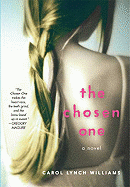 The back of the book promises a compelling coming of age story, and that it is. But it did not quite live up to my hopes for it, for a couple major reasons.
The back of the book promises a compelling coming of age story, and that it is. But it did not quite live up to my hopes for it, for a couple major reasons.
While the voice was incredibly engaging, it did not provide the depth that I was hoping for when addressing the topic at hand, and while the voice suited the character well it did not help the story (if that makes sense). More importantly, however, I was troubled by the characterization of the "bad" characters; they were so two-dimensional that it was impossible to empathize with them in any way. They were one step short of stroking long-haired cats while cackling. And I was really hoping to get more insight about a part of society I blatantly do not understand.
I say this having read it in its entirety in 2 hours, so it's not that it was uninteresting or unreadable... I just was hoping for something much stronger from a book with so much support. I felt like it was a much more superficial effort than what I was expecting.
So, yesterday was one of those great days at the store where everything went right. Teachers came in to buy mass quantities of paperbacks to keep their students reading during the summer, Love, Aubrey (a fantastic middle reader I reviewed in may) came out in hardback, new kids I'd never met came in and bought books I'm passionate about and to top it all off with a big fat scoop of awesomeness, I picked up 5 (5!!) new kid reviewers.
The Kid Reviewer program at my store is simply this: kids who really love books come in and talk to me about the books they like. I make them write a little staff pick card (with the word "staff" covered up with a handwritten "kid") and then I give them a free Advanced Reader Copy for their effort. Best case scenario, they come back in and and write a review for the ARC, but it doesn't always happen that way.
The best thing about the Kid Reviewers is that the only kids who even WANT to do it (it is offered way more than it is done) are kids who are passionate about books, kids who really, really love to read and who are, always, way more intelligent than kids their age have any right to be (which really just means smarter than me). Which are, of course, the kids that are the most fun to talk to.
I finally made a little notebook, in which I can compile things like contact information, birthdays and books reviewed to really keep track, since it's a rapidly expanding program. So hopefully, in the fall we can start doing events.
I left the store yesterday unable to stop smiling. There's a reason working in a bookstore is awesome, and for me, it's kids like the kids I got to talk to yesterday. One of my coworkers suggested a career in teaching. I told her that was a terrible idea. In teaching, you're put in the position of assigning reading, forcing it upon kids, making it a task. At the store, I don't have to do that. The ones who actually WANT to read, and are really passionate about doing so find me. Of course, I love to work with reluctant readers too. If you can hook a kid on reading, it feels fantastic. But there's something so warm, so validating, so heartening about the kids who love it all on their own. Whether or not they're reading books I like (which much of the time they are not) they're reading, and in the age of youtube, Kindle and twitter, it's particularly meaningful. To me. Career nerd.

I found this very short tale of thievery, wrongful accusation and redemption to be an incredibly compelling morality tale. Ok, that probably sounds silly when addressing a story about a goose who is wrongfully accused of a crime actually committed by a well-meaning mouse... but nonetheless I was entirely impressed. In a very accessible way, Steig crafted a very complex moral spectrum. While the mouse (the "real thief") struggles with his inability to right the wrong he has created, Gawain the goose is wracked by the hurt wreaked by his friends who did not stand in defense of his innocence. At fifty-eight pages,
The Real Thief is the perfect length for a two-night read aloud session with parent and child, or even as a single sitting for a child alone. It has all the complexity of a much longer book, in the language and length for a much younger child. Perfect for ages four and five (if being read aloud to) or six (for reading alone) and up, and for kids struggling to cross into chapter books.

The next installment of my Newbery Challenge was
Maniac Magee by Jerry Spinelli, the 1991 Newbery Winner. The lyrical and rhythmic narrative voice of this piece lent itself to an aural effect that fit the content of the story well. Maniac Magee, a little boy who's been running away (from home, from places that are almost home, and places that never felt like home in the first place) and in the meantime cultivates a hero-like mythology about him.
Though the entire book was well-written and enjoyable, my absolute favorite section was when Maniac starts living with Grayson, an old caretaker of the zoo and baseball field. When it turns out that Grayson was a minor league pitcher, he and Magee start to swap baseball advice for reading lessons (Grayson is illiterate). It was an incredibly emotional passage, and the descriptions of Grayson's old, leather baseball glove struck a cord with me particularly.
I wasn't expecting a reference to Stephen Crane's Red Badge of Courage in a book about a pizza/monster killing joint, but there it was. Just sorta tossed in there, as if to tell me, yes, there are werewolf/vampire crossbreeds in this story (called Guttata horridus, guttata meaning spotted in latin according my to coworker, Bob) but that does not mean this is a story without brains.
 Which is not to say that Greg Taylor's Killer Pizza is going to be assigned in schools anytime soon. It's a campy horror story that was made to be fun and not entirely nutritious, just like the pizza it centers around. It's a very simple story about good friends, evil monsters (G versus E, as Taylor puts it), and secret aspirations. And while some of the dialog can be a little clunky, and the Japanese American girl is somewhat defined by her heritage in a predictable manner (Samurai blood, huh? yeah, me too, but I don't think I'd go for a career in lethal monster control, give me reasons better than that) and a little of what I like to think of as protagonist pampering (my, Toby, your bod is so hot now!) it's still a very enjoyable read, similar in essence to the Goosebumps books I used to DEVOUR in elementary school.
Which is not to say that Greg Taylor's Killer Pizza is going to be assigned in schools anytime soon. It's a campy horror story that was made to be fun and not entirely nutritious, just like the pizza it centers around. It's a very simple story about good friends, evil monsters (G versus E, as Taylor puts it), and secret aspirations. And while some of the dialog can be a little clunky, and the Japanese American girl is somewhat defined by her heritage in a predictable manner (Samurai blood, huh? yeah, me too, but I don't think I'd go for a career in lethal monster control, give me reasons better than that) and a little of what I like to think of as protagonist pampering (my, Toby, your bod is so hot now!) it's still a very enjoyable read, similar in essence to the Goosebumps books I used to DEVOUR in elementary school.
With genuinely scary moments and action to spare, Killer Pizza is the perfect summer read for kids getting just a little too old for Goosebumps, yet not quite as graphic as Christopher Pike or even RL Stine's Fear Street (am I dating myself? We don't even sell those authors anymore...) and certainly less frightening than Neil Gaiman's Coraline. It will also, I think, do well with adults who have an affection for B horror movies.
It's just a typical Saturday night-- you know, sex, drugs, rock and roll. Or, reading kids books.
Ok, just the kids books part.
First, I finished the 1973 Newbery Winner, The Witch of Blackbird Pond, by Elizabeth George Speare. It's historical fiction, set in a little

Puritan settlement. The protagonist, Kit, who was raised in Barbados, moves there when her grandfather/guardian dies. A strong-willed girl with a rebellious streak, Kit attracts more attention than she bargained for in her new home. But it is not until she befriends a little old Quaker woman named Hannah, who many in the town think is a witch, that she begins to feel at home. Unlike some historical children's fiction, The Witch of Blackbird Pond avoids dullness and dryness with plenty of romance, namely between Kit and the dashing sailor boy, Nat. However, I did have two qualms with this book: firstly, that several of the minor characters were a bit flat, namely Kit's cousins, Mercy, who is such a Polyanna I could barely stand it, and Judith, who is so self-centered and vain that it's impossible to relate to her on ay level. Secondly, the plot wraps up with a happily ever after that I found too good to be true. I know it doesn't take place in Salem, but I'm pretty sure accused witches didn't typically end up with their lover of choice. And I wondered, what good does it do to sanitize history for kids' sake? Everything is so peac
hy in the end, all the girls get the boys they want, slanderers go punished, and little old Quakers go safe and free... So, while it was an enjoyable read, (with nice historical details, of course) it was not my favorite Newbery Winner so far.
Dear Mr. Henshaw, by Beverly Clearly, won the Newbery in 1984, which also happens to be the year I was born. And I'm pretty sure the book is aging more gracefully than I am. When I
started this whole Newbery Challenge, this is exactly the kind of book I was hoping to
find. Dear Mr. Henshaw is a book of letters and diary entries
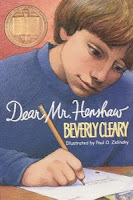
that a little boy named Leigh Botts writes to his favorite author, who ultimately gives him the advice to try writing himself. It is a suggestion that Leigh takes very seriously, and his voyage as a writer begins in his diary. Clearly expertly maneuvers through a very difficult constraint to create a book that is at times funny, sad and always, always honest. She doesn't let the narrative voice get in her way of telling a very true feeling story wrought with realistic emotional travails, and yet still infused with humor. It's the perfect book for reading aloud together for kids who are starting to read more substantial chapter books on their own, but could also be the perfect book for any kid who may look to writing as an outlet. I wish that I had read this book when I was eight or nine. Maybe I would have started writing earlier.
So, I loved (loved) the first Hunger Games book by Suzanne Collins. I read it all in one delicious gulp. And when I found the ARC for the second book, Catching Fire, I was thrilled not only to get a chance to see what happens to Katniss Everdeen, but also so happy that it was just as good as the first installment! Because the best part about getting to read this was not knowing what was going to happen, there will be NO SPOILERS in this review, so this might sound a little vague...
 But it was awesome! Just as quickly-paced as the first installment, just as exciting. The twists are so plentiful in this plot that my head was spinning (in a good way) and I loved getting to know this dark, dystopian world better. Collins justifies her violent plot with sound thematic work (that I would explicate, but will not for fear of ruining the plot) and if you thought the first book was dark, well, it certainly doesn't get any lighter. Heart-thumpingly exciting, with sprinkles of humor, romance and always a dose of rebellion, Catching Fire was better than I could even have imagined. Due out in September from Scholastic, it is sure to please reluctant and voracious readers alike. Just like the first.
But it was awesome! Just as quickly-paced as the first installment, just as exciting. The twists are so plentiful in this plot that my head was spinning (in a good way) and I loved getting to know this dark, dystopian world better. Collins justifies her violent plot with sound thematic work (that I would explicate, but will not for fear of ruining the plot) and if you thought the first book was dark, well, it certainly doesn't get any lighter. Heart-thumpingly exciting, with sprinkles of humor, romance and always a dose of rebellion, Catching Fire was better than I could even have imagined. Due out in September from Scholastic, it is sure to please reluctant and voracious readers alike. Just like the first.
And if you haven't read the first yet, seriously. It's time.
So the internet has been down at my house for the last week... but in that time I read three Newbery Winners that I would break into two categories: fun and edifying. While all three were well written, only one really caught my attention as the type of book that would be fun for kids. The other two I could see having more value for teachers, and would make the best kind of homework.
The first, the 1930 Newbery Winner, The Cat Who Went to Heaven by Elizabeth 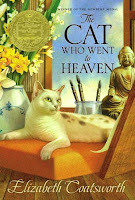 Coatsworth, is essentially an introduction to Buddhism for children. It's the story of an artist in Japan who is commissioned by a temple to paint the death of Buddha, a scene which includes a wide variety of animals. When his housekeeper picks up a stray cat, despite the fact that household can hardly afford another mouth to feed, the artist unwittingly begins his journey to a new understanding of the Buddha. As he paints each animal, he considers the various traits they each represent, and searches to see honor in them all. Meanwhile, he becomes closer to his cat. And though cats did not visit the Buddha when he died, he ultimately decides to include one in the painting, causing his pet to die of happiness. Beautifully written, and pleasantly concise, The Cat Who Went to Heaven is a great book for parents who want their younger children to learn about Buddhism, though may not be a good choice for reluctant readers, or readers looking for adventure in their stories.
Coatsworth, is essentially an introduction to Buddhism for children. It's the story of an artist in Japan who is commissioned by a temple to paint the death of Buddha, a scene which includes a wide variety of animals. When his housekeeper picks up a stray cat, despite the fact that household can hardly afford another mouth to feed, the artist unwittingly begins his journey to a new understanding of the Buddha. As he paints each animal, he considers the various traits they each represent, and searches to see honor in them all. Meanwhile, he becomes closer to his cat. And though cats did not visit the Buddha when he died, he ultimately decides to include one in the painting, causing his pet to die of happiness. Beautifully written, and pleasantly concise, The Cat Who Went to Heaven is a great book for parents who want their younger children to learn about Buddhism, though may not be a good choice for reluctant readers, or readers looking for adventure in their stories.
 The Twenty-One Balloons, by William Pene DuBois, on the other hand is a fantastically fun read with enough hot air-balloon travel and explosions for any reader. It won the Newbery in 1948, and is the story of a San Francisco math teacher who decides to escape his boring life in lieu of a hot air balloon adventure. When he crash lands on the Pacific Island of Krakatoa, a paradise laden with diamonds, he encounters a strange, utopian society of former San Francisco residents. And though Krakatoa is a volatile volcano, the residents have an escape plan. A clever tale with humor to spare, The Twenty-One Balloons was a pleasure to read, with fantastic illustrations by the author. It would be well suited for a family read aloud with younger kids, as it's an entirely wholesome tale and all the air travel a reader can handle.
The Twenty-One Balloons, by William Pene DuBois, on the other hand is a fantastically fun read with enough hot air-balloon travel and explosions for any reader. It won the Newbery in 1948, and is the story of a San Francisco math teacher who decides to escape his boring life in lieu of a hot air balloon adventure. When he crash lands on the Pacific Island of Krakatoa, a paradise laden with diamonds, he encounters a strange, utopian society of former San Francisco residents. And though Krakatoa is a volatile volcano, the residents have an escape plan. A clever tale with humor to spare, The Twenty-One Balloons was a pleasure to read, with fantastic illustrations by the author. It would be well suited for a family read aloud with younger kids, as it's an entirely wholesome tale and all the air travel a reader can handle.
The 1996 Newbery Winner, The Midwife's Apprentice, by Karen Cushman is a story of self-realization, packed with wonderful historical details. The realities of childbrith in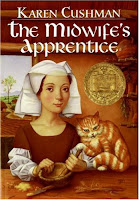
middle ages are hardly sugar-coated, and while it is an incredibly short book (128 pages) it is hardly suited for readers younger than maybe ten years old. (The book says ages 12 and up, but those ages always skew older than I necessarily think they need to.) While I found it an entirely edifying read, and was attached to the characters, I would still qualify this as the type of book best suited for classrooms, unless the child in question has a preexisting interest in historical fiction. Nonetheless, it is beautifully written, immaculately structured and fully deserving of its prize.
View Next 23 Posts


.jpeg)
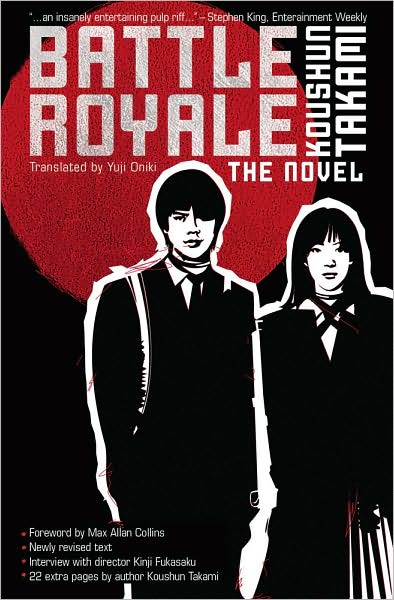


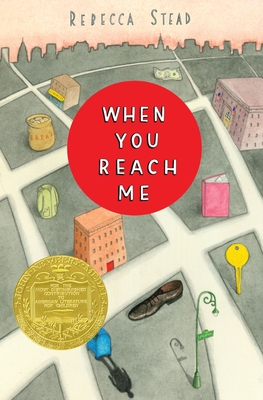

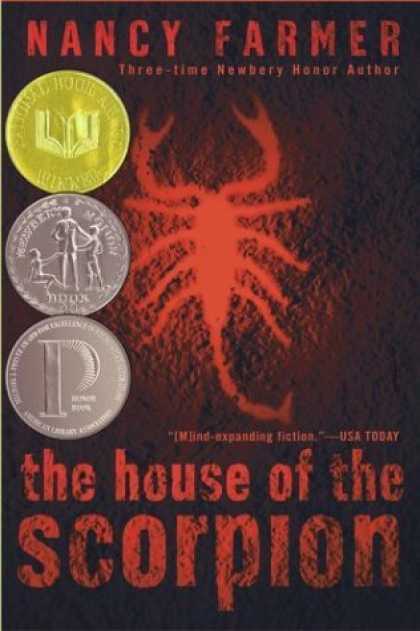

 in less than two hundred pages, he doesn't just address the writer's side, but also the process in which stories are created and the many mechanisms within stories that make them move forward. Hence the very apt comparison to clocks, which are, throughout the entire story, a relentless motif. That was my reading of it.
in less than two hundred pages, he doesn't just address the writer's side, but also the process in which stories are created and the many mechanisms within stories that make them move forward. Hence the very apt comparison to clocks, which are, throughout the entire story, a relentless motif. That was my reading of it.




















LUV this book so much I still reread it on occasion to decompress from work. Smart, terrifying, funny and presents a diverse group of kids without a lot of super sanctimonious preaching about difference. The sequel, The Gypsy Game, wasn't nearly as good.
Wow, surprising to hear that Egypt Game and Mixed-Up Files came out the same year. If it had been up to me they'd have been co-winners, I can't choose which I like better.
TG
This is the best book review I've ever read.
And yeah, this book rocks. I absolutely loved it when I was a kid and always secretly wanted to stage all the ceremonies myself, especially after grandma brought us back those sarcophagi-shaped pencil cases from the british museum. good to know my copy's still safe...